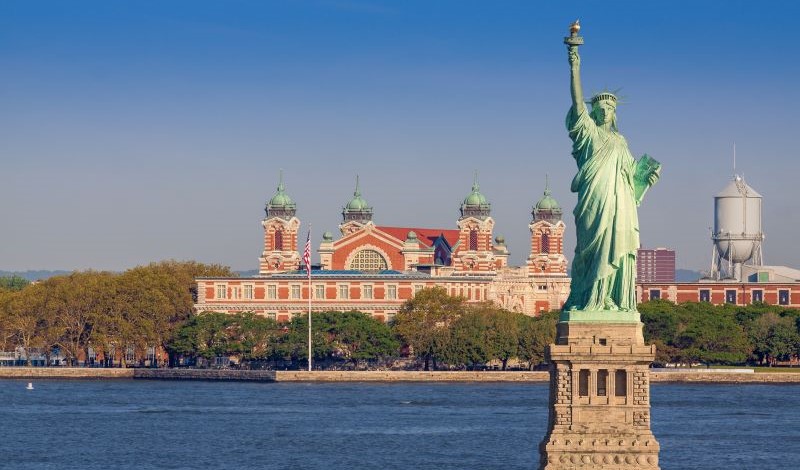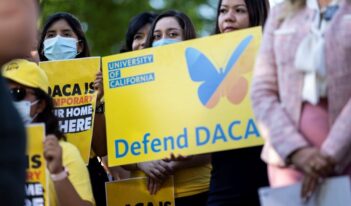
Scholar challenges the history of judicial deference to federal immigration law and policy.
Even skeptics of strict immigration policies accept that the Constitution grants Congress and the executive branch sweeping authority to regulate immigration.
In a recent article, New York University School of Law Professor Adam Cox contests the origins of “immigration exceptionalism,” the doctrine holding that the political branches of government exercise extraordinary discretion over immigration policy, subject only to limited oversight from the courts.
Although scholars typically trace the origins of immigration exceptionalism to the late 19th century, Cox argues that federal courts did not treat immigration law as categorically distinct from other areas of administrative law until the Cold War. Cox ultimately concludes that the Supreme Court did not rely on immigration exceptionalism doctrine to justify upholding an otherwise illegal policy until 2018, when it upheld President Donald Trump’s travel ban in Trump v. Hawaii.
Cox contends that three seminal nineteenth century cases commonly cited as establishing immigration exceptionalism—Chae Chan Ping v. United States, Fong Yue Ting v. United States, and Nishimura Ekiu v. United States—actually displayed the same understanding of due process and individual rights as did contemporaneous nonimmigration cases.
These three cases addressed whether noncitizens had the right to enter or remain in the United States. Chae Chan Ping and Fong Yue Ting examined race-based laws affecting Chinese individuals, while Nishimura Ekiu upheld a law permitting the exclusion of individuals deemed “likely to become a public charge.”
Reviewing this trio of cases, Cox analyzes the Court’s language describing the political branches’ ability to regulate immigration as an “incident of sovereignty,” and their determinations in immigration proceedings as “conclusive upon the judiciary.”
Other scholars have interpreted these phrases as evidence of the emerging immigration exceptionalism doctrine, but Cox argues that this language reflected then-conventional due process principles rooted in the separation of powers.
Cox explains that in the 19th century, federal courts strictly distinguished between private rights guaranteed by the Constitution and public rights or privileges administered by the government. When the government deprived individuals of private rights, courts interpreted the Constitution’s due process protections to require a trial before a judge.
By contrast, in governmental actions depriving someone of a public right or privilege, federal courts understood that the political branches determined the necessary procedures, if any. Cox describes the distinction between public and private rights as “largely dichotomous—basically an all-or-nothing proposition” in determining due process requirements.
Courts commonly disagreed, however, as to whether a given right was private or public. Further confounding these classifications, courts sometimes determined that a public right became “vested” in an individual, entitling that person to the due process protections of a trial. Cox contends that disagreements about these contested categories, rather than immigration exceptionalism doctrine, determined the outcomes of the foundational immigration law cases.
Cox notes, for example, that in Chae Chan Ping, Justice Field supported the Court’s unanimous decision to uphold the exclusion of a Chinese immigrant—and former U.S. resident—whose reentry certificate Congress had invalidated. Justice Field dissented in Fong Yue Ting, however, a decision upholding the deportation of a Chinese immigrant who lacked a required certificate of residence. Cox attributes Justice Field’s shift to his understanding that residency in the United States—even without citizenship—manifested an individual right to remain, and that the political branches could not abridge this right without a trial.
These seminal cases were decided, Cox explains, shortly before federal courts “cast aside” their 19th century understanding of due process in public law cases. Although they still considered agencies’ findings of fact “conclusive upon the courts,” Cox explains that courts created exceptions to this rule when proceedings were “manifestly unfair,” such as when they lacked a proper hearing or adequate evidence.
For example, in the 1903 Supreme Court case Yamataya v. Fisher, the government sought to exclude a Japanese teenager under the public charge rule, much as it did in Nishimura Ekiu, decided in 1892. The plaintiff in Yamataya contested the procedural fairness of these proceedings, including because she did not understand the questions posed by an immigration inspector in English.
The Supreme Court sided with the government in Yamataya, although it concluded that due process required some sort of hearing—if only an administrative hearing rather than a federal-court trial— before excluding the plaintiff. Cox characterizes this decision as a sharp break with Nishimura Ekiu, in which the Court found the immigration inspector’s determination binding, even without a hearing.
Cox contends that the Yamataya decision demonstrated a shift toward the “appellate model” of due process in administrative law, in which courts reviewed agency actions for consistency with the law while deferring to agencies’ factual findings. Although appellate review was less searching than a full trial, Cox indicates that the adoption of the appellate model “revolutionized” courts’ approach to administrative law cases.
As federal courts began to play a more robust role in reviewing agency decision making, Cox argues that they did not treat immigration cases as exceptional. Instead, immigration law changed in tandem with—and at the forefront of—administrative law. Cox cites a Department of Labor report from 1940 describing procedural fairness requirements in immigration proceedings as representing a “a transformation in judicial doctrine” compared to earlier cases such as Nishimura Ekiu and Fong Yue Ting. The report, Cox explains, documented the requirement for procedural fairness in both exclusion and deportation proceedings, undercutting arguments that the uniquely weak legal position of noncitizens seeking entry obviated the need for due process.
Cox instead suggests that immigration exceptionalism doctrine emerged from cases decided in the 1950s, most importantly United States ex rel. Knauff v. Shaughnessy and Shaughnessy v. United States ex rel. Mezei, each upholding the exclusion of noncitizens from entering at Ellis Island. In deciding these cases, the Supreme Court did not accept the government’s argument that excluding noncitizens prior to entry did not require a hearing, Cox explains. Instead, the Court cited language in decisions such as Fong Yue Ting and Nishimura Ekiu declaring immigration policy the exclusive province of the political branches.
Cox concludes that the Knauff and Mezei decisions overlooked decades of jurisprudence developing immigration law, instead importing the language of 19th century cases without regard to historical context. The Supreme Court thereby “invented” a new reading of these decisions “that set the stage for the development of the modern plenary power.”
In the following decades, the Supreme Court did rely on immigration exceptionalism to support its decisions, Cox argues, but avoided deciding whether this doctrine alone could justify upholding discriminatory immigration policies that antidiscrimination jurisprudence would otherwise prohibit.
Cox contends that immigration exceptionalism never determined the outcome in a case challenging an allegedly discriminatory immigration policy until 2018, when the Court affirmed the legality of President Trump’s travel ban in Trump v. Hawaii. Chief Justice Roberts concluded that the ban would only violate the Constitution if it were “impossible to discern a relationship to legitimate state interests,” or if “that policy is inexplicable by anything but animus.” By relying on immigration exceptionalism to avoid analyzing evidence of anti-Muslim animus motivating the ban, Cox argues that the Court “turned canonical antidiscrimination doctrine on its head.”
The modern immigration exceptionalism doctrine “may be more an invention of the Roberts Court than the Fuller Court of the late nineteenth century,” Cox concludes. He contends that scholars and practitioners should understand immigration law as part of public law and recognize the role of immigration cases in developing administrative law.



